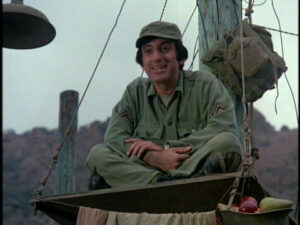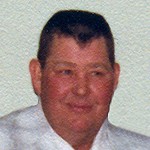MASH

 As its name indicated, “pole sitting is the practice of sitting on top of a pole (such as a flagpole) for extended lengths of time, generally used as a test of endurance.” When you first hear the words, it might generate a picture in your mind of someone trying to sit on the little ball that is on top of most flag poles, but actually, a small platform was typically placed at the top of the pole for the sitter…thankfully. The 1920s fad originated with stunt actor and former sailor Alvin “Shipwreck” Kelly, and it became a fad in the mid-to-late 1920s, but mostly died out after the start of the Great Depression. I suppose that during the Great Depression, there just didn’t seem to be an interest in silliness like that.
As its name indicated, “pole sitting is the practice of sitting on top of a pole (such as a flagpole) for extended lengths of time, generally used as a test of endurance.” When you first hear the words, it might generate a picture in your mind of someone trying to sit on the little ball that is on top of most flag poles, but actually, a small platform was typically placed at the top of the pole for the sitter…thankfully. The 1920s fad originated with stunt actor and former sailor Alvin “Shipwreck” Kelly, and it became a fad in the mid-to-late 1920s, but mostly died out after the start of the Great Depression. I suppose that during the Great Depression, there just didn’t seem to be an interest in silliness like that.
Pole sitting is actually a much older practice than you might think. It was predated by the ancient ascetic discipline of stylitism, which is basically column-sitting. Saint Simeon Stylites the Elder, who lived about 388–459, of Antioch (now Turkey) was a column-sitter who sat on a small platform on a column for 36 years. Why??? I don’t understand the purpose of something like that…at least not in that era. These days it is most likely a way of setting some outlandish record. It seems that getting into the Guiness Book of World Records is a great way of obtaining some recognition.
It seems that something like that was the idea, when 14-year-old William Ruppert broke the pole sitting record of 23 days, in 1929. “Shipwreck” Kelly’s initial 1924 sit lasted 13 hours and 13 minutes. It soon became a big fad with other contestants setting records of 12, 17, and 21 days. In 1929, “Shipwreck” Kelly decided to reclaim the title. He sat on a flagpole for 49 days in Atlantic City, New Jersey, setting a new record. As with all records, the race to top it was on, and the following year, 1930, his record was broken by Bill Penfield in Strawberry Point, Iowa, who sat on a flagpole for 51 days and 20 hours, until a thunderstorm forced him down. Let’s face it while sitting on a pole to break a record was a “fun” idea, it was not something they were willing to lose their lives over. For the most part, pole sitting was confined to the 1920s, ending start of the Depression.
Then, a 37-year-old Ohio resident named Marshall Jacobs, who was trying to revive the fad, married his fiancée Yolanda Cosmar atop a flagpole with a roost in 1946. A wedding photograph of them kissing gained wide attention. In 1949, Cleveland resident Charley Lupica sat atop a flagpole platform for 117 days, to support the Cleveland Indians in their pennant race against the New York Yankees. A serious fan of the Cleveland Indians, Lupica, after an argument with Yankees fans, began sitting on a flagpole above his grocery store on May 31. He claimed he would stay on the pole until the Indians either claimed first place in the standings or were eliminated from contention. Unfortunately for him, the Indians never passed the Yankees, and Lupica came down during the Indian’s final home game on September 25. Indians owner Bill Veeck had moved Lupica and the flagpole to Cleveland Municipal Stadium the night before as a promotional stunt. Richard “Dixie” Blandy claimed various records as champion at 77, 78 between 1933 to 1963. Then, he sat 125 days until he died on May 6, 1974, in Harvey, Illinois when the 50 feet pole on which he was sitting collapsed. Peggy (Townsend) Clark set a record of 217 days in 1964 in Gadsden, Alabama. Pole sitting was also used for other things. From November 1982 to January 21, 1984, a total of 439 days, 11 hours, and 6 minutes, H David Werder sat on a 
 pole to protest against the price of gasoline. The game show “What’s My Line” hosted by John Charles Daly, got in on the action when a flagpole sitter is the first guest on the July 3, 1955, episode. It even came into the television show, M*A*S*H, when everyone got in on the fun, encouraging Klinger to stick it out, including Colonel Potter learns that the Army record for pole sitting is 96 hours. Potter turned the tables on Klinger by convincing him to stay up there to break the record. Finally, it died out again, unless someone else decides to pick it up again.
pole to protest against the price of gasoline. The game show “What’s My Line” hosted by John Charles Daly, got in on the action when a flagpole sitter is the first guest on the July 3, 1955, episode. It even came into the television show, M*A*S*H, when everyone got in on the fun, encouraging Klinger to stick it out, including Colonel Potter learns that the Army record for pole sitting is 96 hours. Potter turned the tables on Klinger by convincing him to stay up there to break the record. Finally, it died out again, unless someone else decides to pick it up again.
 My Uncle Elmer died in 1981. Most of his nieces and nephews never got a chance to know him very well. The other day, his son, Elmer was telling me some of the stories of his dad’s childhood, and the mischief he and his 2 brothers got into. This story reminds me a little bit of some of the MASH episodes. Having had no brothers myself, I didn’t really understand the inner workings of the minds of three brothers who were egging each other on. The story Elmer told, goes like this…
My Uncle Elmer died in 1981. Most of his nieces and nephews never got a chance to know him very well. The other day, his son, Elmer was telling me some of the stories of his dad’s childhood, and the mischief he and his 2 brothers got into. This story reminds me a little bit of some of the MASH episodes. Having had no brothers myself, I didn’t really understand the inner workings of the minds of three brothers who were egging each other on. The story Elmer told, goes like this…
One day Uncle Elmer was plowing with an old tractor at his dad’s place. His dad went out to use the outhouse, which is what they used back then. That is when Uncle Elmer and his brother Les got an idea. Uncle Elmer drove the tractor right up by the outhouse. His brother Les hit the outhouse with a 2×4 as Uncle Elmer revved up the engine. Their dad came running out of the outhouse with his pants down around his ankles and the Montgomery Ward’s catalog in hand. Their dad wasn’t very happy with them, but he was relieved that the outhouse made it through whole ordeal in good shape.
Of course, not many of us knew Elmer’s grandfather, but he was quite the man in his own right. He pumped oil out in Midwest early in his adult life, but in the 1940’s he received a piece of property on Poison Spider Road in the Homestead Act. He continued to pump oil in Midwest while he and his wife and sons built the house on Poison Spider Road. The boys lived in an old crude oil tank that had been cut in half, like a Quonset hut. It had a dirt floor and a pot belly stove for heat. In the Fall, the boys learned early on, to throw something on the floor before getting out of bed. Apparently the rattlesnakes liked these cozy surroundings, and as the weather grew cooler. A throw rug thrown on the floor was a good way to alert you that danger was on the floor, and so your feet shouldn’t be.
Yes, what Uncle Elmer didn’t think of, his brother Les did. Their brother Tom was the baby and therefore wasn’t involved as much, but he had a mischievous side too. Elmer figures it is an inherited trait, and one that probably got Tom is as much trouble later on, such as when the boys were racing their Harley’s out by Evansville. I don’t know how many of you know about the Evansville area, but the police out there don’t take much to racing…if you know what I mean. I’m sure Uncle Elmer and his brothers found that out too.

